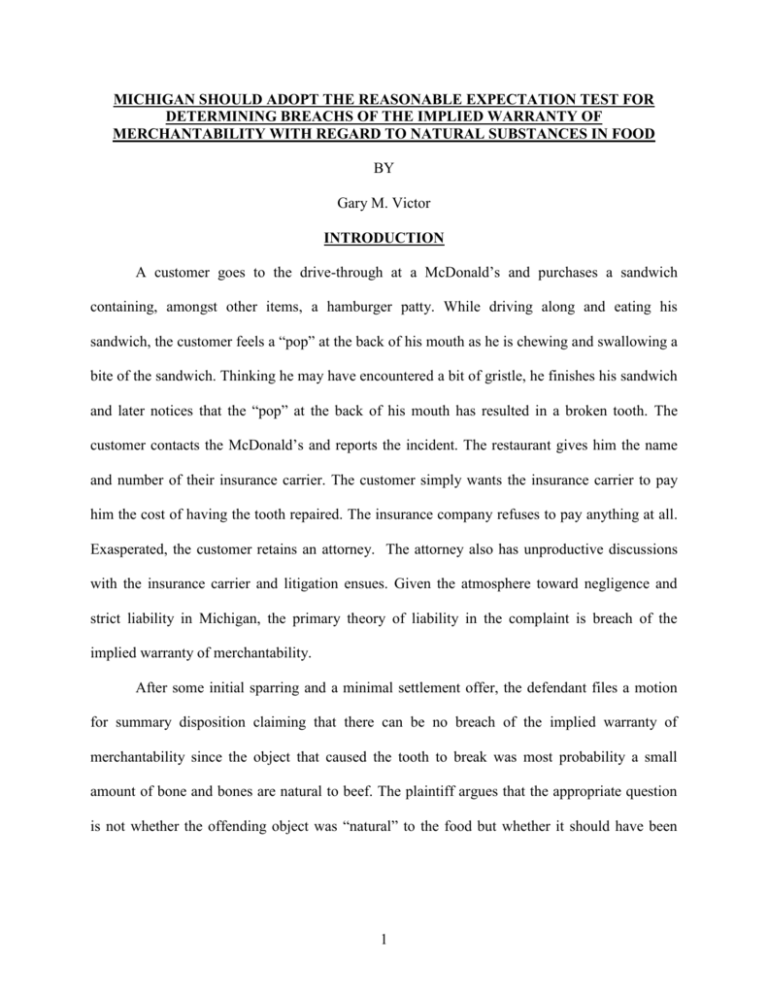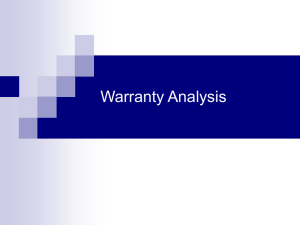Foreign-Natural vs Reasonable Expectation article
advertisement

MICHIGAN SHOULD ADOPT THE REASONABLE EXPECTATION TEST FOR DETERMINING BREACHS OF THE IMPLIED WARRANTY OF MERCHANTABILITY WITH REGARD TO NATURAL SUBSTANCES IN FOOD BY Gary M. Victor INTRODUCTION A customer goes to the drive-through at a McDonald’s and purchases a sandwich containing, amongst other items, a hamburger patty. While driving along and eating his sandwich, the customer feels a “pop” at the back of his mouth as he is chewing and swallowing a bite of the sandwich. Thinking he may have encountered a bit of gristle, he finishes his sandwich and later notices that the “pop” at the back of his mouth has resulted in a broken tooth. The customer contacts the McDonald’s and reports the incident. The restaurant gives him the name and number of their insurance carrier. The customer simply wants the insurance carrier to pay him the cost of having the tooth repaired. The insurance company refuses to pay anything at all. Exasperated, the customer retains an attorney. The attorney also has unproductive discussions with the insurance carrier and litigation ensues. Given the atmosphere toward negligence and strict liability in Michigan, the primary theory of liability in the complaint is breach of the implied warranty of merchantability. After some initial sparring and a minimal settlement offer, the defendant files a motion for summary disposition claiming that there can be no breach of the implied warranty of merchantability since the object that caused the tooth to break was most probability a small amount of bone and bones are natural to beef. The plaintiff argues that the appropriate question is not whether the offending object was “natural” to the food but whether it should have been 1 reasonably expected by the consumer so that the consumer could defend against it; and that the issue, therefore, should go to the jury. The above scenario sets up a conflict between two tests which have been applied by different courts in determining whether there is a breach of the implied warranty of merchantability when consumers are injured by items in food that are related to the food (natural), but not intended to be present in the product as presented (unexpected). This article will examine the law, the two tests, the absence of Michigan precedent on the issue and the reasons why Michigan should adopt the reasonable expectation test. THE APPLICABLE LAW MCL § 440.2314, the Uniform Commercial Code section establishing an implied warranty of merchantability, reads, in pertinent part, as follows: (1) Unless excluded or modified . . ., a warranty that the goods shall be merchantable is implied in a contract for their sale if the seller is a merchant with respect to goods of that kind. Under this section the serving for value of food or drink to be consumed either on the premises or elsewhere is a sale. (2) Goods to be merchantable must be at least such as (c) are fit for the ordinary purposes for which such goods are used. Under this provision, there is no doubt that the purchase of food is subject to the implied warranty of merchantability. That warranty will be breached if the food is not fit for the ordinary purposes such goods are used—not fit for human consumption. This is where the two possible tests come into play. THE TWO TESTS1 THE FOREIGN-NATURAL TEST Most writers will credit the genesis of what has become known as the “foreign-natural” test to the 1936 California Supreme Court case of Mix v Ingersoll Candy Co.2 In a case involving 2 injuries resulting from a customer swallowing a fragment of chicken bone in a chicken pie, the Court stated: We have no hesitancy in so holding, and we are of the opinion that despite the fact that a chicken bone may occasionally be encountered in a chicken pie, such chicken pie, in the absence of some further defect, is reasonably fit for human consumption. Bones which are natural to the type of meat served cannot legitimately be called a foreign substance, and a consumer who eats meat dishes ought to anticipate and be on his guard against the presence of such bones.3 Under this “foreign-natural” test, the inquiry is whether the object that caused the consumer’s injury is natural to one or more of the ingredients of the food without regard to the fact that the object would not ordinarily be intended to be part of the finished product. If the object is natural in that respect, the defendant is entitled to summary disposition.4 THE REASONABLE EXPECTATION TEST Not long after the Mix foreign-natural test began to take hold, another line of reasoning was developing in other states. It started with the rejection of the proposition that a food selling defendant would be entitled to summary disposition simply because the item that caused the injury was natural, leaving the question of liability to the jury. One example is the 1942 Pennsylvania Supreme Court case of Bonenberger v Pittsburg Mercantile Co.5 In Bonenberger, the consumer was injured by swallowing a piece of oyster shell while preparing oyster stew using canned oysters purchased from the defendant. The Court rejected defendant’s argument based on oyster shells being natural to oysters and held: We cannot say as a matter of law that the product furnished the plaintiffs was reasonably fit for human consumption. The jury should be carefully instructed that it is their duty to determine from the facts that question.6 Eventually, courts began to more clearly articulate an alternative test. 7 A good example is the 1960 Supreme Court of Wisconsin case: Betehia v. Cape Cod Corp.8 In this chicken bone in a chicken sandwich case, the Court stated: 3 The “foreign-natural” test applied as a matter of law does not recommend itself to us as being logical or desirable. It is true one can expect a T-bone in T-bone steak, chicken bones in roast chicken, pork bone in a pork chop, pork bone in spare ribs, a rib bone in short ribs of beef, and fish bones in a whole baked or fried fish, but the expectation is based not on the naturalness of the particular bone to the meat, fowl, or fish, but on the type of dish served containing the meat, fowl, or fish. There is a distinction between what a consumer expects to find in a fish stick and in a baked or fried fish, or in a chicken sandwich made from sliced white meat and in roast chicken. The test should be what is reasonably expected by the consumer in the food as served, not what might be natural to the ingredients of that food prior to preparation. What is to be reasonably expected is a jury question in most cases; at least, we cannot say as a matter of law that a patron of a restaurant must expect a bone in a chicken sandwich either because chicken bones are occasionally found there or are natural to chicken.9 Under the “reasonable expectation” test the inquiry was no longer limited to whether the object that caused the injury was natural to the food; but whether the consumer could reasonably expect, prepare for and defend against the danger. Perhaps more importantly, in all but a very few instances10 this test puts the issue before the jury. THE MICHIGAN POSITION OR THE ABSENSE THEREOF There are no reported Michigan cases discussing the foreign-natural test and the reasonable expectation test. The case which appears most closely on point is the1969 Court of Appeals case of Martel v Duffy-Mott, Corp.11 Martel involved applesauce consumed by two children, one of whom reported that it did not smell or taste good. After gagging, their mother took them to the nearest hospital where the hospital staff made the decision to pump the children’s stomachs. A claim was brought against the manufacturer alleging negligence and breach of warranty. The trial court granted a directed verdict for the defendant on the basis that there had been no proof showing of anything deleterious in the applesauce. In reversing, the Court of Appeals stated: The trial court erroneously assumed that food is necessarily ‘fit for the ordinary purposes' if it is not deleterious. There was indeed no evidence that the applesauce contained any deleterious substance. However, it was not therefore to 4 be regarded as merchantable as a matter of law.12 *** It is the business of juries to determine the credibility of witnesses, to sift out the conflicting claims and to decide the disputed issues. If they go too far afield, it is the trial judge's and our responsibility to correct error. We should not deny recovery of just claims because of fear we cannot recognize and exclude the malingerer.13 Although the Martel Court did not specifically discuss and reject the foreign-natural test and adopt the reasonable expectation test, like the Court in Bonenberger v Pittsburg Mercantile Co14 discussed above, the Michigan position appears to be that the question of whether the there has been a breach of warranty of merchantability with regard to food should be left to the jury. On the other hand, it can be said with relative certainty that there are no reported Michigan cases citing the foreign-natural test with approval. Be that as it may, it is time for the Michigan courts to discuss and specifically adopt the reasonable expectation test. The next section of this article will discuss the reasons why. MICHIGAN SHOULD ADOPT THE REASONABLE EXPECTATION TEST Whenever the next opportunity presents itself, the Michigan courts should adopt the reasonable expectation test regarding “natural” substances in food which cause injury to consumers. They should do so for a number of reasons. First, the test has been adopted by the only two of our sister states that have considered the issue. Second, the foreign-natural test has been subject to much legitimate criticism. Third, reasonable expectation test is much more consistent with the intention of the Uniform Commercial Code. With regard to our sister states, in Betehia v. Cape Cod Corp.15 discussed above, the Wisconsin Supreme Court specifically rejected the foreign-natural test in favor of the reasonable expectation test. The Supreme Court of Ohio considered the two tests in Allen v. Grafton16, a case involving injuries from oyster shell in fried oysters. The Court concluded: 5 We are inclined to agree with the statement in Dickerson, Products, Liability and the Food Consumer (1951), 185, Sections 4.2 and 4.3, that reads: ‘Insofar as these cases rest on the notion of ‘naturalness' in the sense that nothing that is an inherent part of the raw product itself can be a legal defect, they do not hold water. * * * ‘The better test of what is legally defective appears to be what consumers customarily expect and guard against.'17 Thus, both Ohio and Wisconsin have adopted the reasonable expectation test. Michigan should join them. The foreign-natural test as received a great deal of criticism in both cases18 and legal commentary;19 the same can not be said for the reasonable expectation test. For example, in Janes, Products Liability--The Test of Consumer Expectation for "Natural" Defects in Food Products,20 the author puts it this way: In an era of consumerism, the foreign-natural standard is an anachronism. It flatly and unjustifiably protects food processors and sellers from liability even when the technology may be readily available to remove injurious natural objects from foods. The consumer expectation test, on the other hand, imposes no greater burden upon processors or sellers than to guarantee that their food products meet the standards of safety that consumers customarily and reasonably have come to expect from the food industry.21 If the consumer is injured by food containing poison, glass, rocks or any substance not natural to one or more ingredients of the food as served; the seller will be liable for a breach of the implied warranty of merchantability under either the foreign-natural test or the reasonable expectation test. Therefore, it appears that the only function of the foreign-natural test is to allow the sellers of food to escape liability when whatever is contained in the food is natural but unexpected. Such a result is not only both unfair and plain silly; it is inconsistent with the intention of the Uniform Commercial Code. 6 The failure of the foreign-natural test to meet the intention of the implied warranty of merchantability section of the Uniform Commercial Code is best summed up in the following quote from the conclusion of Note, Breach of Implied Warranty: Has the Foreign/Natural Test Lost Its Bite?:22 The majority of jurisdictions that have addressed cases concerning deleterious, naturally occurring substances in food are moving toward adoption of the reasonable expectation test. There are jurisdictions, however, that continue to cling to the antiquated and confusing foreign/natural test. It is the failure to recognize the inability of the foreign/natural test to adapt to changing realities of the consumer marketplace that results in inequitable decisions and denies recovery to plaintiffs injured by objects that no ordinary consumer would expect to find in the finished food dish. This failure also undermines the reasoning behind adoption of the breach of implied warranty provisions of the Uniform Commercial Code that provide relief for injured consumers without requiring a showing of negligence on the part of the manufacturer or supplier. Application of the foreign/natural test rather than the reasonable expectations test evidences a misunderstanding of the nature of the implied warranty of merchantability with respect to food. The foreign/natural test presumes that the implied warranty refers to the absence of any foreign substances in the food. The true nature of the warranty, however, is that it guarantees that the food will be merchantable, implying that the food can be consumed without resulting injury or illness. Therefore, application of the foreign/natural test does not adequately represent the provisions of the Code because it bases recover on a misstatement of the nature of the warranty.23 CONCLUSION In this modern age of fasts food restaurants and people eating out a great deal of time, it is not uncommon for consumers to be injured by substances in food that may be natural to one of more of the ingredients of the food but not intended to be part of the final product. When such injured consumers bring claims for breach of the implied warranty of merchantability, they are often confronted with motions for summary disposition based on the “naturalness” of the offending substance. Currently, there are two possible tests in determining whether food containing substances that are natural but not intended is fit for human consumption. Under the “foreign-natural” test, if the offending object is natural to the food it is presumed to be fit for 7 human consumption as a matter of law and the seller is entitled to summary judgment. Under the “reasonable expectation” test, the question is whether the consumer would have reasonably expected and been able to defend against the substance in the food as served. In all but a few situations, this test puts the question to the jury. Michigan has no reported cases analyzing the two rules and choosing a position. The closest case, Martel v Duffy-Mott, Corp,24appears to leave the question of food fitness to the jury. This article has argued that whenever the issue is presented to a higher Michigan court, the court should adopt the reasonable expectation test. Two of our sister states, Wisconsin and Ohio have adopted the test. Also, the foreign-natural test has been subject to much criticism as outdated and unfair because the only apparent function of that test is to allow the sellers of food to escape liability whenever the substance that injures the consumer is natural but unexpected. Additionally, the foreign-natural test is inconsistent with the intention of the implied warranty of merchantability provision of the Uniform Commercial Code which is designed to permit injured consumers a remedy without a show of negligence. 1 For a discussion of the two tests and the cases applying each, see, Jane Massey Draper, Liability for injury or death allegedly caused by food product containing object related to, but not intended to be present in, product, 2 ALR 5th 189 (1992). See also, Note, Breach of Implied Warranty: Has the Foreign/Natural Test Lost Its Bite?, 20 Mem St U L Rev 377 (Spring, 1990). 2 59 P2d 144 (1936). 3 Id at 148 4 See, eg, Title v Pontchartrain Hotel, 449 So 2d 677 (1984, La App 4th Cir); Coffer v Standard Brands, Inc, 226 SE2d 534 (1976, NC App); Norris v Pig'n Whistle Sandwich Shop, 53 SE2d 718 (1949, Ga App). 5 28 A2d 913 (1942). 8 6 Id at 915. For a discussion of the development and application of the two tests, see, Jackson v Nestle-Biech Inc, 569 NE2d 1119 (1991, Ill App). 8 103 NW2d 64 (1960). 9 Id at 68-69. 10 See, eg, Webster v. Blue Ship Tea Room, Inc, 198 N.E.2d 309 (1964, Mass) where the Court held that fish bones in fish chowder were reasonably expected as a matter of law. 11 15 Mich App 67 (1969). See also, the unpublished case of Bramble v Hormel Foods Corp, 2000 WL 33538512 (Mich.App. Jan 28, 2000) 12 Id at 70-71. 13 Id at 73-74. 14 28 A2d 913 (1942). 15 103 NW2d 64 (1960). 16 164 NE2d 167 (1960). 17 Id at 174. It should be noted that even though the Allen Court adopted the reasonable expectation test, it somewhat inconsistently held as a matter of law that the consumer should have reasonably expected the oyster shell and reversed in favor of the seller. See also, Thompson v Lawson Milk Company, 356 NE2d 309 (1976, Oh App), where the Court held that whether gristle hard enough to break a tooth in chopped ham should have been reasonable expected by the consumer was a question for the jury. 18 See the quote above from Betehia v. Cape Cod Corp, 103 NW2d 64 (1960). See also, Jackson v Nestle-Biech Inc, 569 NE2d 1119, 1124 (1991, Ill App). 7 After reviewing the foregoing we conclude that the foreign-natural doctrine originally set forth in Mix and adapted by the second district in Goodwin should not be followed. It is not merely a matter of the passage of time and the changing of attitudes that leads us to this conclusion. It appears to us that Mix and its progeny (which obviously includes Goodwin) have been unsound from the outset. 19 See, eg, Note, Breach of Implied Warranty: Has the Foreign/Natural Test Lost Its Bite?, 20 Mem St U L Rev 377 (Spring, 1990); Twerski, The Role of the Judge in Tort Law: From Risk, Utility to Consumer Expectations: Enhancing the Role of Judicial Screening in Product Liability Litigation, 11 Hofstra LRev 861 at 930-933 (1983); Janes, Products Liability--The Test of Consumer Expectation for "Natural" Defects in Food Products, 37 Ohio St LJ 634, 651-52 (1976); Schag, Consumer Expectation--The Test of a Substance Natural to a Food as a Legal Defect, 15 Food Drug Cosm.LJ 311 (1960). 20 37 Ohio St LJ 634 (1976) 21 Id at 652. 22 20 Mem St U L Rev 377 (Spring, 1990). 23 Id at 407-408. 24 15 Mich App 67 (1969). See also, the unpublished case of Bramble v Hormel Foods Corp, 2000 WL 33538512 (Mich.App. Jan 28, 2000) 9






